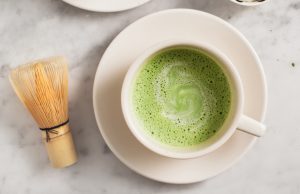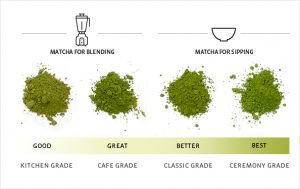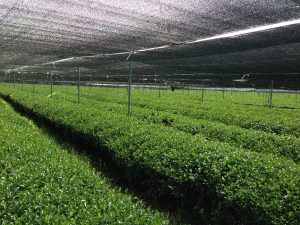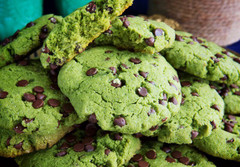What is Matcha Tea?
 Matcha is a form of green tea. Its unique quality is that it is a fine powder – comprised of stone ground tea leaves. When Matcha tea is consumed the whole tea leaf is consumed rather than just the liquid brew from the infused leaf – which is the case with most forms of tea.
Matcha is a form of green tea. Its unique quality is that it is a fine powder – comprised of stone ground tea leaves. When Matcha tea is consumed the whole tea leaf is consumed rather than just the liquid brew from the infused leaf – which is the case with most forms of tea.
The idea of preparing and consuming powdered tea originated in China many hundreds of years ago and become a ritual by Zen Buddhists. It has been recorded that a Chinese Buddhist monk introduced Matcha powdered tea to Japan 1191. As a result Matcha tea has become an integral part of Japanese society and has been celebrated for hundreds of years in the Japanese tea ceremony.
In recent years, many Western countries have come to embrace the virtues of Matcha tea especially in the health and beauty circles – so much so that now it has become one of the most sought after “health beverages” on the market.
How is Matcha Tea Made?
Matcha tea is made from the same Camellia Sinensis tea plant as other green teas (as well as black teas, oolong teas and white teas for that matter). Aside from the fact that it is ground into powder, there are a couple of other key differences with Matcha tea in its early stages of production. Firstly the tea plants are carefully shaded several weeks prior to harvesting (the same process that is used for gyokuro green tea) to avoid the leaves being exposed to direct sunlight. This process causes the growth of the leaves to slow down and as a result the leaves turn a deeper green color with higher levels of chlorophyll and a sweeter taste. Once ready, the finest and tenderest leaves only are plucked from the tea plants and steamed to prevent oxidization and then laid out to dry. Traditionally, the tea leaves for Matcha tea are dried outside in the open in a the closely shaded environment. In more recent years this drying process is more commonly done indoors.
What is Tencha?
Once the tea leaves have been dried, the next step is to separate the veins and stems from the main part of the leaf. This part that remains after drying and de-stemming and de-veining is the finest part of the tea leaf used for grinding into Matcha powder. This is referred to as Tencha – the high quality tea leaf fully ready for stone grinding into fine ground Matcha powder. it is important that the Tencha leaf does not get exposed to direct sunlight or become oxidized in any way.
Stone Grinding the leaves
For over 750 years, Matcha tea was traditionally ground by hand using a stone mill. Nowadays large automated granite stone mills are used and as a result the talc like powder has a very uniform consistency. Grinding the leaves properly however, is still a slow and tedious process. It is important that the mill stones do not get too hot during the grinding process, as it can affect the delicate aroma of the leaves and cause the Matcha to become “burnt” and thereby causing degraded quality . It can sometimes take up to an hour to prepare 30 grams of premium grade Matcha.
Storage
Some Matcha tea makers recommend keeping the tea as Tencha for 6 -12 months before grinding into Matcha powder in order to get the finest quality Matcha. Tencha is usually stored in a cool, dry place – often in a refrigerator. Once the Tencha has been ground into Matcha, the shelf life is reduced considerably. Usually 1 – 2 years is the maximum time for Matcha powder if is kept in a sealed bag or container. Once the Matcha powder is opened it is advisable to use it within 1 – 2 months in order to maintain maximum freshness.
Different Grades of Matcha
 Ceremonial grade Matcha is the premium grade that is usually made from the first pick of the spring harvest and often from older, more mature tea plants. This tea is very expensive and usually only available in limited quantities each year. This Matcha tea is usually made into a thicker tea called Koicha which is an exclusive part of the traditional Japanese tea ceremony. Of course Koicha can also be enjoyed by anyone. The other type of Matcha tea preparation is called Usucha which is a lighter, thinner and not usually as sweet and smooth tasting as Koicha.
Ceremonial grade Matcha is the premium grade that is usually made from the first pick of the spring harvest and often from older, more mature tea plants. This tea is very expensive and usually only available in limited quantities each year. This Matcha tea is usually made into a thicker tea called Koicha which is an exclusive part of the traditional Japanese tea ceremony. Of course Koicha can also be enjoyed by anyone. The other type of Matcha tea preparation is called Usucha which is a lighter, thinner and not usually as sweet and smooth tasting as Koicha.
Regular grades of Matcha tea powder are also often used in other forms of drinks and cooking recipes such as Matcha smoothies, lattes, ice-cream, cakes, and much more. In fact there are literally 100s of food and drink recipes available using Matcha.
How you you like to enjoy Matcha?
For information on the health benefits of Matcha Tea please refer to this article.






Hi Peter,
I must have been living in the dark ages as I’d never heard of Matcha tea before. It looks wonderful and the reviews from your Amazon link are excellent. It sounds like a super food with so many health benefits, looks lovely in those cookies too.
Healthy Matcha cookies!
I live in the UK and am a huge traditional tea drinker but I will be purchasing some Matcha tea through your link and will let you know what I think.
Do you use Matcha in any cooking recipes?
Thanks for your interesting article,
Simon.
Hi Simon. Yes, many people do classify Matcha as a Superfood and is an excellent ingredient to add to green drinks and healthy smoothies. There are lots of Matcha recipe books around these days. Here are a couple of good ones on Amazon: Healthy Matcha Cookbook and Superfoods – Matcha Green Tea